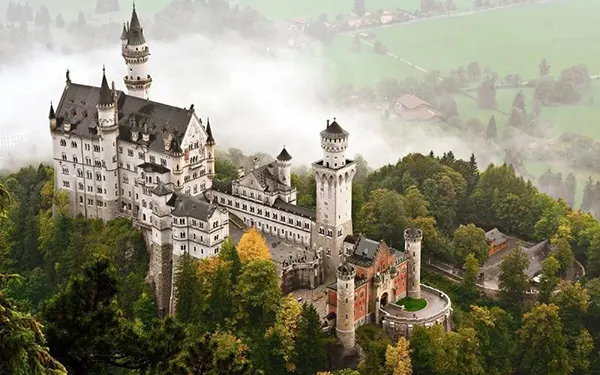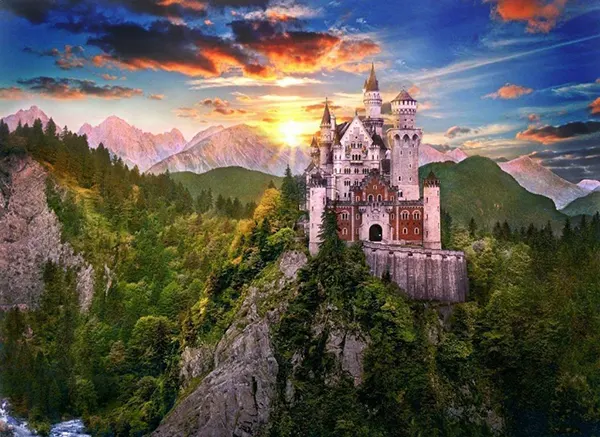
Neuschwanstein Castle, Germany: The Story of the Dreamy King Ludwig II
Neuschwanstein Castle is one of the most iconic architectural landmarks in the world, attracting millions of visitors each year. Built in the late 19th century, it stands in the Bavarian Alps as a testament to the vision and ambitions of King Ludwig II of Bavaria. With its fairy-tale silhouette, the castle has become a symbol of romantic architecture and a reflection of the king’s fascination with art, music, and medieval legends. Despite its magical appearance, the history behind it is complex, blending political struggles, financial challenges, and the king’s deep desire to escape into a world of his own imagination.
The Origins and Vision Behind Neuschwanstein
The idea for Neuschwanstein Castle was conceived by King Ludwig II in 1868, shortly after Bavaria’s loss in the Austro-Prussian War. Ludwig sought to create a retreat away from political pressures, inspired by the operatic works of composer Richard Wagner and the romantic ideals of medieval chivalry. The king wanted a personal refuge rather than a functional royal residence, envisioning a place where he could immerse himself in art and solitude. The chosen location near the village of Hohenschwangau offered dramatic landscapes and a personal connection, as Ludwig had spent much of his youth in the nearby Hohenschwangau Castle.
The architectural design was entrusted to Christian Jank, a theatrical set designer, whose romanticised plans incorporated towers, spires, and elaborate interiors. The project was ambitious both in scale and cost, blending Romanesque Revival elements with whimsical details. Construction began in 1869, but progress was slow due to the remote mountainous setting and Ludwig’s constant modifications to the plans.
From the beginning, Neuschwanstein was not intended as a practical fortress but as an artistic creation. Ludwig’s vision included lavishly decorated halls inspired by Wagner’s operas, such as the Hall of the Singers and the Throne Room, both richly adorned with murals depicting Germanic legends and Christian iconography. This blend of romantic fantasy and medieval revival was a direct reflection of the king’s personal tastes and ideals.
Challenges During Construction
The building of Neuschwanstein was plagued by delays and financial strain. Ludwig II funded the project primarily from his personal fortune and through borrowing, as the Bavarian government refused to finance what they saw as a private indulgence. The costs escalated rapidly, far exceeding the original estimates, leading to political tension between the king and his ministers. By the mid-1880s, Ludwig’s spending on his castles had caused significant debt, intensifying scrutiny over his rule.
Technological challenges also slowed the work. The castle’s location on a rugged hilltop required innovative engineering solutions, including the construction of access roads, water supply systems, and the use of modern materials alongside traditional stonework. Despite the difficulties, Ludwig insisted on perfection, often rejecting completed work if it did not match his expectations.
By the time of Ludwig’s mysterious death in 1886, only a fraction of the planned rooms had been completed. Nevertheless, the finished sections were richly decorated and stand today as masterpieces of 19th-century romantic architecture. The incomplete parts of the castle remain a reminder of both the grandeur and the tragedy of Ludwig’s dream.
The Role of Richard Wagner’s Influence
King Ludwig II’s admiration for Richard Wagner played a central role in shaping Neuschwanstein’s design. The castle was conceived as a tribute to the composer’s works, particularly his operas based on medieval myths such as “Tannhäuser” and “Lohengrin.” Ludwig saw himself as a patron of the arts, and Neuschwanstein became an architectural embodiment of the dramatic, emotional, and mythical worlds that Wagner brought to life on stage.
The Hall of the Singers, for example, was modelled after the Wartburg Castle’s historic hall but decorated with murals depicting scenes from Wagner’s operas. Similarly, the Throne Room was designed as a Byzantine-style space with mosaics and gold accents, reflecting both Christian symbolism and theatrical grandeur. These artistic choices transformed the castle into more than just a residence—it became a stage for Ludwig’s personal fantasy, where architecture and music merged.
Wagner himself never visited Neuschwanstein, as he died before its completion, but the influence of his works remains evident in nearly every aspect of the castle’s interior. Even the remote and dramatic setting mirrors the landscapes described in Wagnerian operas, enhancing the sense of stepping into a mythical realm.
Cultural and Historical Impact
Neuschwanstein’s Wagnerian themes have contributed to its enduring cultural legacy. The castle has become a symbol of romanticism and artistic vision, inspiring countless artists, writers, and filmmakers. It famously served as the model for the Sleeping Beauty Castle at Disneyland, further cementing its place in popular culture. Beyond entertainment, it represents the late 19th-century movement that sought to revive medieval styles in a modern context.
Historically, the castle stands as a testament to the tensions between monarchy and modern state governance in Bavaria. Ludwig’s devotion to art and personal escapism contrasted sharply with the political realities of his time, ultimately leading to his isolation and deposition. Yet his creation has outlasted the politics of the era, becoming one of Germany’s most visited tourist attractions.
Today, Neuschwanstein is recognised not only for its beauty but also for the story it tells about a ruler torn between duty and dreams. It remains a tangible expression of an individual’s attempt to preserve beauty and legend in a rapidly industrialising world.

Neuschwanstein in the 21st Century
In 2025, Neuschwanstein continues to attract around 1.4 million visitors annually, making it one of the most popular destinations in Germany. Preservation efforts are ongoing, as the castle’s location and age present challenges to maintaining its structural integrity. Restoration projects focus on both the exterior stonework and the delicate interior murals, ensuring that the artistry envisioned by Ludwig II remains vibrant for future generations.
Modern tourism infrastructure has been carefully integrated to balance accessibility with conservation. Visitor numbers are managed through timed ticketing, and sustainable transport options such as electric shuttle buses are now in use to reduce environmental impact. The castle also benefits from digital technologies, with virtual tours allowing global audiences to experience its beauty without physical travel.
Neuschwanstein’s role in Bavarian cultural identity remains strong. It is a key site for regional history, art history education, and international cultural exchange, hosting exhibitions and events that highlight the era of Ludwig II and the romantic movement in architecture. Its continued popularity proves the timeless appeal of a dream brought to life in stone.
Legacy of King Ludwig II
King Ludwig II’s legacy is inseparable from Neuschwanstein. Though his reign was marked by controversy and his life ended under mysterious circumstances, his passion for beauty, art, and imagination is immortalised in the castle’s walls. He is often remembered as the “Fairy Tale King,” a title that captures both admiration for his vision and recognition of his unconventional approach to kingship.
In modern historical assessments, Ludwig is viewed not merely as an eccentric ruler but as a cultural visionary who used architecture to express ideals that transcended politics. Neuschwanstein serves as a physical narrative of his personal story—a blend of idealism, isolation, and artistic devotion. It also stands as an example of how a leader’s personal passions can create a cultural landmark that endures for centuries.
Ultimately, the castle’s global recognition ensures that Ludwig II’s dream will continue to inspire. Whether appreciated for its architectural brilliance, romantic imagery, or the human story behind it, Neuschwanstein remains a masterpiece that bridges history, legend, and art.
